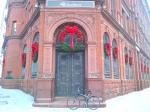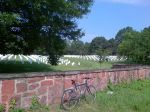The first person to be buried at what would become known as Arlington National Cemetery (MAP) was not a soldier. It was not someone unknown, like those buried in the cemetery at the Tomb of the Unknowns or the Civil War Unknowns Memorial. It was also not Robert E. Lee, who owned the house and surrounding property where the cemetery is now located. The first person buried there was not even a man. The first person to be buried at Arlington National Cemetery was a woman named Mary Randolph. And after encountering her grave on this bike ride to the cemetery, I wanted to learn more about her.
Mary Randolph was born on August 9, 1762, the oldest of 13 children born to Thomas Mann Randolph, Sr. and Anne Cary Randolph, one of the richest and most politically significant families in 18th century Virginia. Her father was orphaned at a young age and raised by Thomas Jefferson’s parents who were distant cousins. Her father also served in the Virginia House of Burgesses, the Revolutionary conventions of 1775 and 1776, and the Virginia state legislature. Anne Cary Randolph was the daughter of Archibald Cary, an important Virginia planter. Additionally, one of her brothers, Thomas Mann Randolph, Jr., married Martha Jefferson, daughter of Thomas Jefferson, and became a Congressman and Governor of Virginia. And one of her sisters, Harriet, married Richard Shippey Hackley who became US Consul to Spain. The Randolphs were also descendants of Thomas Rolfe and his wife, the legendary Pocahontas.
Mary was born at Ampthill Plantation in Chesterfield County, Virginia, and grew up at Tuckahoe Plantation in Goochland County, Virginia. And as might be expected in a family of their wealth, her parents hired professional tutors to teach their children. So Mary learned reading, writing, and arithmetic, as well as domestic skills and proper household management practices, qualities expected of upper-class women of that time.
In December 1780, 18-year-old Mary married her first cousin once removed, David Meade Randolph, a Revolutionary War officer and tobacco planter. The newlyweds lived at Presquile, a 750-acre plantation that was part of the Randolph family’s extensive property in Chesterfield County, Virginia. Around 1795 President George Washington appointed her husband the U.S. Marshal of Virginia, and by 1798, she and her family had moved to Richmond. In Richmond they built a house they named “Moldavia”, a combination of Molly, a nickname for Mary, and David, where they settled in and Mary became a celebrated hostess and their home became a center of Federalist Party social activity. However, David Randolph, as a member of the Federalist Party and an open critic of his second cousin Thomas Jefferson, would soon encounter hard times. After Jefferson’s election to the presidency, he removed David Randolph from office and the family’s fortunes declined.
Within a few years, despite her husband’s subsequent employment with the Black Heth Coal Mines near Midlothian, Virginia, their family’s financial situation had become critical. And in 1807 Mary stepped in so that her family could continue to enjoy their accustomed standard of living, an unorthodox step for an upper-class woman. She opened a boardinghouse in Richmond. While running the boardinghouse, she was listed on the census as the head of the household. But that was only because her husband was traveling in England on business for his new job. During her time running the boarding house, Mary continued to enjoy some benefits of the family’s wealth, including an early version of a refrigerator. Mary also began compiling a cookbook during this time.
By 1819, the couple, in advancing years, gave up their boardinghouse and moved to D.C. to live with their one of their eight children, four of whom survived to adulthood. While in D.C., Mary Randolph completed her cookbook and in 1824 published it. The cookbook was entitled “The Virginia House-Wife.” And although neither she nor anyone else at that time could have known, it would become synonymous with fine cuisine in Virginia, and Mary’s biggest claim to fame.
After its initial publication, which was an immediate success, The Virginia House-wife was republished an additional nineteen times before the outbreak of the Civil War. The book was 225 pages long, included nearly 500 recipes, and later versions even included sketches for the early version of a refrigerator that Mary had in her Richmond boardinghouse. Years later an author claimed that Mary invented the refrigerator and that her design was stolen and patented by a Yankee who stayed in her boardinghouse. But that claim has never been proven.
The Virginia House-Wife is considered the first regional American cookbook, and exhibited a uniquely Virginian style, featuring recipes for such Southern classics such as okra, sweet potatoes, biscuits, fried chicken, barbecue pork, and lemonade. However, her occasional explanations of uniquely southern foods she anticipated an audience beyond her region. And other recipes included in here cookbook were for dishes influenced at times by African, Native American, and European cooking, such as gazpacho, ropa vieja, polenta, macaroni, as well as six curry recipes, which were the first curry recipes published in the United States. It also included a few recipes for specialties from other parts of the U.S., such as a recipe entitled “Dough Nuts – A Yankee Cake,” as well as the first ice cream recipe published by an American author.
It should be noted, however, that The Virginia House-Wife was more than just a cookbook. It was also an overall household guide, In addition to recipes it also explained how to make such things as soap, starch, blacking and cologne.
After finding out about Mary Randolph and The Virginia House-wife, I checked and discovered that it is still in print. I was surprised. It’s been 196 years and it’s still available. The hardback edition sells for $21.95. But I also found the Kindle version, and it was available for free. So I downloaded it. And I’m now looking forward to trying out some of the recipes. However, to be honest, there are some recipes I don’t anticipate trying anytime soon, such as Knuckle of Veal, Soused Pig’s Feet in Ragout, and Grilled Calf’s Head.
The epitaph on Mary’ Randolph’s gravestone reads:
Sacred to the memory of
Mrs. Mary Randolph
her intrinsic worth needs no eulogium
The deceased was born
The 9th of August, 1762
at Amphill near Richmond, Virginia
and died the 23rd of January 1828
in Washington City
a victim to maternal love and duty
The historic marker sign next to her grave reads:
Mary Randolph, wife of David Meade Randolph, and first person known to be buried at Arlington, was the eldest child of Thomas Mann and Ann Carey Randolph, of Tuckahoe, her maternal grandfather was Archibald Carey, of Ampthill; her paternal grandfather was William Randolph, of Tuckahoe. She was a direct descendant of Pocahontas: a cousin of Thomas Jefferson: of Mary Lee Fitzhugh Custis, wife of George Washington Parke Custis, the builder of Arlington House: and of Robert E. Lee. Her brother, Thomas Mann Randolph, Governor of Virginia 1819-1821, married Martha Jefferson, daughter of Thomas Jefferson. Her eldest son was William Beverley Randolph, through whom alone her line has descended. Her youngest son, Burwell Starke Randolph, when a midshipman in the U.S. Navy, fell from a mast and was crippled. Her devoted care of that injured son is said to have hastened her death, and would seem to explain her epitaph.
































